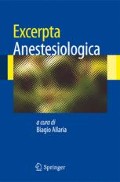Riassunto
Il principio sul quale si basa il convincimento che la GDHT (Goal Directed Hemodynamic Therapy) è importante nel diminuire la mortalità, le complicanze e la LOS (lenght of stay, durata della degenza) dei pazienti a rischio sottoposti a chirurgia (essenzialmente chirurgia addominale, toracica, vascolare, nel politrauma, nei settici e, in genere, chirurgia dove sono prevedibili larghe perdite ematiche) è quello che lo stress chirurgico può essere favorevolmente affrontato solo con una disponibilità di O2 indicizzata (DO2I) adeguata alle esigenze metaboliche (CaO2 · CI · 10 = ⩾ 600 ml/m2/min). In caso contrario l’ossigenazione tessutale può essere insoddisfacente soprattutto in alcuni distretti (in primis quello intestinale) con l’insorgenza di complicanze (per esempio, ileo paralitico di lunga durata) a loro volta causa di altre (per esempio, tachicardia, ipotensione, ischemie miocardiche) che, come minimo, allungano la LOS, ma che possono anche aumentare la mortalità.
Access this chapter
Tax calculation will be finalised at checkout
Purchases are for personal use only
Preview
Unable to display preview. Download preview PDF.
Bibliografia
Boyd O et al (1993) A randomized clinical trial of the effect of deliberate perioperative increase of oxygen delivery on mortality in high risk surgical patients. JAMA 270:2699–2707
Ciofolo MJ (1989) Changes in ventilation, oxygen uptake and CO2 out up during recovery from anesthesia. Anesthesiology 70:737–741
Conway DH et al (2002) Randomized controlled trial investigating the influence of intravenous fluid filtration using aesophageal Doppler monitoring during bowel surgery. Anaesthesia 57:845–849
De Baker D et al (2006) The effects of dobutamine on microcirculatory alterations in patients with septic shock are independent of its systemic effects. Crit Care 34:403–408.
Durairaj L et al (2008) Fluid therapy in resuscitated sepsis. Chest 133:252–263.
Euro J Anaesth 24:1028–1033
Gan TJ et al (2002) Goal directed intraoperative fluid administration reduces length of hospital stay after major surgery. Anesthesiology 97:820–826
Gueret G, Kiss G, Khaldi S et al (2007) Comparison of cardiac output measurements between NICO and the pulmonary artery catheter during repeat surgery for total hip replacement. Eur J Anestesiol 24:1028–1033
Kern JW et al (2002) Meta analysis of hemodynamic optimization in high-risk patients. Crit Care Med 30:1686–1692
Lee GDJ (1994) The pulmonary circulation. In: Wagner WW, Weir EK, The pulmonary circulation and gas exchange, Futura, New York
Lobo SM et al (2000) Effects of maximizing oxygen delivery on morbidity and mortality in high risk surgical patients. Crit Care Med 28:3396–3404
Lobo SM et al (2006) Prospective, randomized trial comparing fluids and dobutamine optimization of oxygen delivery in high risk surgical patients. Crit Care 10:872
Lobo SM et al (2008) Early optimisation of oxygen delivery in high-risk surgical patients. In: Vincente JL (ed), Yearbook of intensive care and emergency medicine, Springer, New York
Mythen MG et al (1995) Perioperative lasma volume expansion reduces the incidence of gut mucosal hypoperfusion during cardiac surgery. Arch Surg 130:423–429
Older P et al (1993) Preoperative evaluation of cardiac failure and ischemia in elderly patients by cardiopulmonary exercise testing. Chest 104:701–704
Older P et al (1999) Cardiopulmonary exercise testing as a screening test for perioperative management of major surgery in the elderly. Chest 116:355–362
Pearse RM et al (2006) Identification and characterization of the high risk surgical population in the United Kingdom. Crit Care 10:R 81
Sageman WS et al (2002) Equivalence of bioimpedance and thermodilution in measuring cardiac index after cardiac surgery. JCVA 16:8–14
Shoemaker WC et al (1988) Prospective trial of supranormal values of survivors as therapeutic goals in high risk surgical patients. Chest 94:1176–1186
Silver MB et al (2004) Evaluation of impedance cardiography as an alternative to pulmonary artery catheterization in Critical ill patients. CHF 10(Suppl 2):17–21
Sinclair S et al (1997) Intraoperative intravascular volume optimisation and length of stay after repair of proximal femoral fracture: Randomized trial. BMJ 315:909–912
Stone MD et al (2003) Effect of adding dopexamine to intraoperative volume expansion in patients undergoing major elective abdominal surgery. Br J Anaesth 91:619–629
Van De Water J et al (2003) Impedance Cardiography — The next vital sign technology? Chest 123:2028–2033
Venn R et al (2002) Randomized controlled trial to investigate influence of the fluid challenge on duration of hospital stay and perioperative morbidity in patients with hip fractures. Br J Anaesth 88:65–71
Wilson J et al (1999) Reducing a risk of major elective surgery: randomized controlled trial of preoperative optimisation of oxygen delivery. BMJ 318:1099–1103
Xiaoming J et al (2008) Risk factors for ARDS in patients receiving mechanical ventilation for >48 h. Chest 188:853–861
Yern SJ et al (2003) Sources of error in noninvasive PCBF measurements by partial rebreathing. Anesthesiology 98:881–887
Author information
Authors and Affiliations
Editor information
Editors and Affiliations
Rights and permissions
Copyright information
© 2011 Springer-Verlag Italia
About this chapter
Cite this chapter
Allaria, B. (2011). Ha ancora un senso la GDHT nel perioperatorio del paziente a rischio?. In: Allaria, B. (eds) Excerpta Anestesiologica. Springer, Milano. https://doi.org/10.1007/978-88-470-2023-8_2
Download citation
DOI: https://doi.org/10.1007/978-88-470-2023-8_2
Publisher Name: Springer, Milano
Print ISBN: 978-88-470-2022-1
Online ISBN: 978-88-470-2023-8
eBook Packages: MedicineMedicine (R0)

